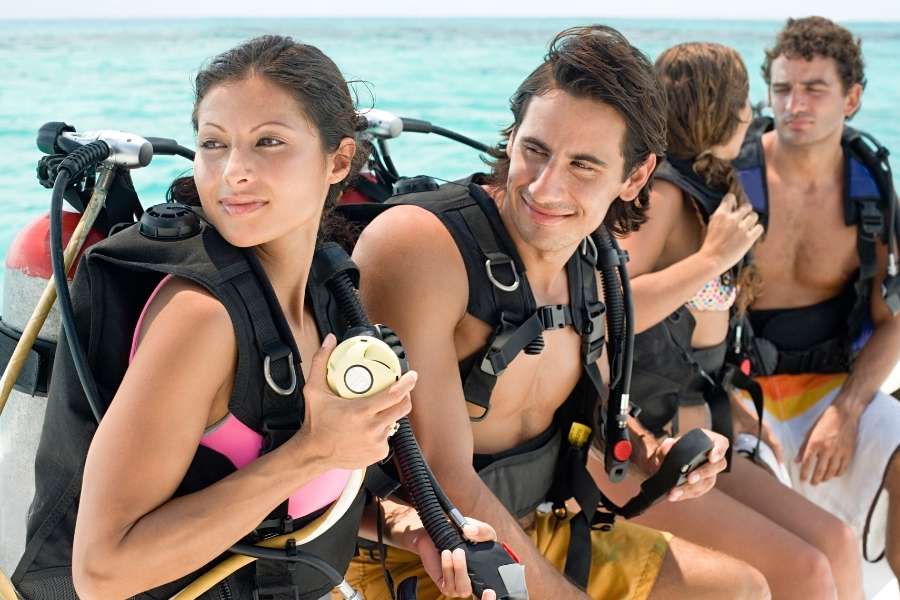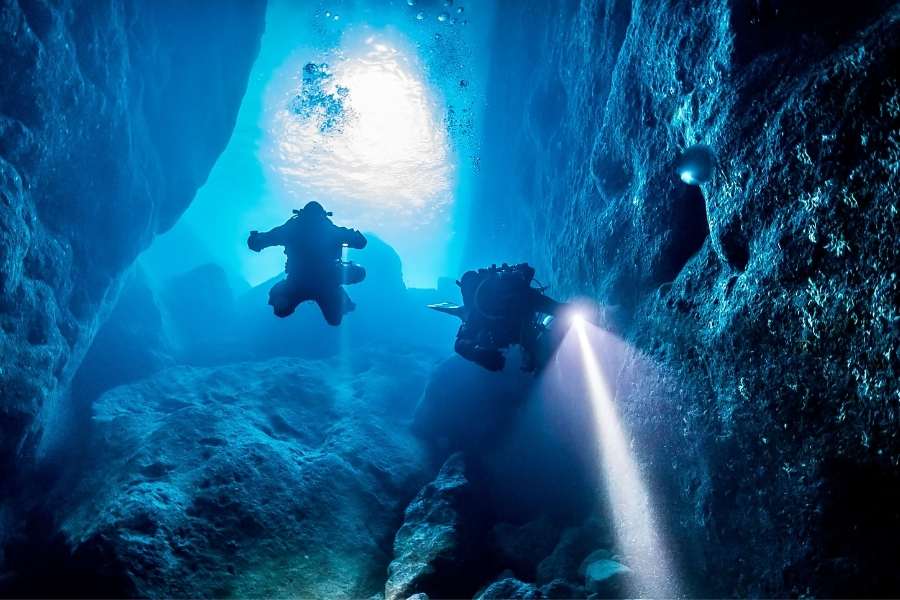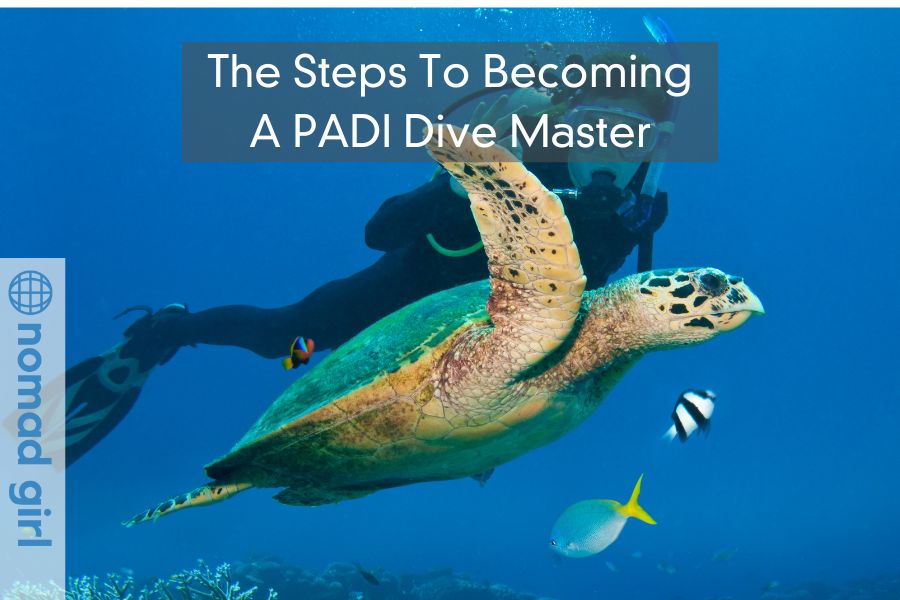It took me over ten years to go from being a certified Open Water diver to a Dive Master (and then an Open Water Scuba Instructor), but it’s possible to do it a lot more quickly than I did. These are the steps you’ll need to follow to become a Dive Master:
Open Water (3+ days)
This is your first stepping stone into the world of diving. The course teaches you all the basics; things like what happens to your body under pressure and how to handle different kinds of current in the ocean. The course usually lasts between three and six days, consisting of both theory and practical sessions. You’ll take home a book and complete the knowledge review at the end of each chapter after reading it. Then you’ll go over the answers in the classroom (or a towel on the beach, or feet dangling off a dock…), watch some videos, and take some quizzes and a final exam. If you don’t want to waste precious holiday time studying, completing the e-Learning option beforehand is a great idea instead so you get all the theory finished and just do the fun stuff while away.
When it comes to the practical side of things you’ll be eased into the diving experience naturally with a review of all the equipment and then instruction on how to set it up and how it all works. Your first session will take place in confined water; usually a pool or a calm and shallow bay, where you’ll go through a series of skills to handle simple problems that might occur underwater. You’ll also spend some time mastering neutral buoyancy which is one of the most crucial skills to become a good, responsible diver.
After completing the skills you’ll finally be let loose into open water where you might feel a little nervous at first but your instructor will be right by your side. You’ll soon get used to the feeling of weightlessness and breathing underwater and feel as free as a bird, or I suppose, a fish! The open water dives are more about enjoying the experience and having fun, although there are a few skills to complete for each of the four dives. Then, once your paperwork has gone through, and your mug shot posed for, you’ll be certified to dive to a depth of 18m, anywhere in the world!

Advanced Open Water (2+ days)
This course includes five adventure dives and a small amount of theory. For each adventure dive you do, you’ll need to read the corresponding chapter in the Adventures in Diving manual and answer the questions in the knowledge reviews at the end of each chapter. Your instructor will go over the answers with you and check them.
The Deep Adventure dive is one of two compulsory adventure dives that are part of the course. You’ll dive to a maximum of 30 metres and look at a few different things, like how colours change at depth and comparing depth gages. The Underwater Navigation dive is the other compulsory dive and you’ll learn skills like how to use a compass and how to measure distance underwater.
For the other three dives, you can flick through the Adventures in Diving manual and pick out whichever appeal to you. Obviously, this depends somewhat on where you are; we find it difficult to provide the Altitude dive in the Caribbean, for instance. One adventure dive I would personally recommend is the Peak Performance Buoyancy dive, because buoyancy is one of the most important skills to master, and it takes practice to get it right! It’ll usually include some games with your instructor; sometimes swimming through hoops, or knocking over weights in the sand with your regulator.

EFR (Emergency First Response) (1 day)
For anyone wanting to do the Rescue course, this is a prerequisite, although both courses can be taught at the same time and often are. You’ll spend a day in the classroom learning how to respond to emergency situations and provide both primary and secondary care in different situations. As usual, it’s a mix of theory and practical, so be prepared to bandage and be bandaged! If you’ve taken an EFR course within the last 24 months then you don’t need to take it again; you’ll just have to show your EFR card.
Rescue Diver (3+ days)
The Rescue Diver is where diving all becomes a little more serious. Instead of only thinking about yourself in the water, you’ll start thinking about others too. It will change your diving because after the course you’ll start assessing potentially dangerous situations and stepping in if you see something going wrong. You’ll learn invaluable skills and will know what to do in an emergency, whether you’re dealing with a panicked diver, or finding an unconscious diver underwater. It’s an intense course but really fun at the same time and definitely very rewarding.
There’s a fair bit of theory to get through as you’ll need to know all sorts of things, for instance, how to spot the symptoms of decompression sickness, and how to prepare an emergency assistance plan. The book has five chapters which you’ll have to read and then complete the knowledge reviews at the end of each, which you’ll go through afterwards with your instructor. There is also a video to watch which will reinforce the information from the book, and it’s helpful to see the skills being performed before you do them. You’ll be required to pass a final exam as well.
The practical side of things includes being taught a number of skills in confined water, practising them in open water, and then demonstrating them in a variety of rescue scenarios where you’ll put your newfound skills to use to save several ‘victims’ from whatever fate becomes them. There is a big learning curve on this course and you should expect it to be challenging but great fun.
Dive Master (14+ days)
To embark on becoming a Dive Master you’ll have to have completed the four previous courses, as well as logged a minimum of 40 dives. You’ll also need to have logged 60 dives by the time you’ve finished, demonstrated all the skills proficiently and assisted in various courses and scenarios. The theory includes the longest book yet, which again you’ll be expected to read from cover to cover and complete all the knowledge reviews which you’ll go over with your instructor. There is also an exam (which you’ll need to study for), however, apart from this usual structure, the Dive Master course is a little different from all of the others.
How so? Well, it’s way more than just theory and ticking off skills. The emphasis is on getting experience as a diver; by diving often, but also by shadowing Instructors and qualified Dive Masters. You’ll learn to become a valuable assistant, and while you’re doing the course, you’ll be known as a Dive Master in Training (or DMT).
One of the most important skills you’ll learn during your Dive Master, especially if you plan to work in diving, is how to deal with customers. You’ll be there to help them form their first step in the shop; selling courses, helping with their equipment (and washing it too, later), assisting on the dive or the course, and maybe even receiving a tip too!

You’ll also hone many of your skills as a diver; your buoyancy, your knowledge of the ocean, how to control a group of divers, how to quickly put up a surface marker buoy, and how to navigate underwater. These are just some of the important things you’ll learn to do with ease, but to get there will take time and practice. This is why I recommend making your Dive Master as long as possible. Some centres will offer it in two weeks but I strongly recommend you take at least a month or two for this course.
It wouldn’t be right not to mention the social aspect of many Dive Master programs. Lifelong friendships are often born and it’s really important to find a place that suits you and where you feel comfortable. After all, you’ll be spending a lot of time there! And when you finally become a fully-fledged Dive Master you’ll naturally want to celebrate! Depending on where you are in the world this may or may not entail the dreaded snorkel test, as well as other fun and games with copious amounts of alcohol involved. But when the party’s over, what does it actually mean now that you’re a Dive Master?
If you choose to work as a Dive Master, you’ll probably find that most of your time will be spent taking certified Open Water and Advanced divers on fun dives. Your job may include some or all of the following: selling trips, dealing with payment, washing gear, carrying tanks, sweeping the floor, helping customers gear up, giving dive and boat briefings, pointing out wildlife, and managing customers professionally and safely. Just like all the things you should have done during your training, but with one very important difference: you’ll be getting paid!


















